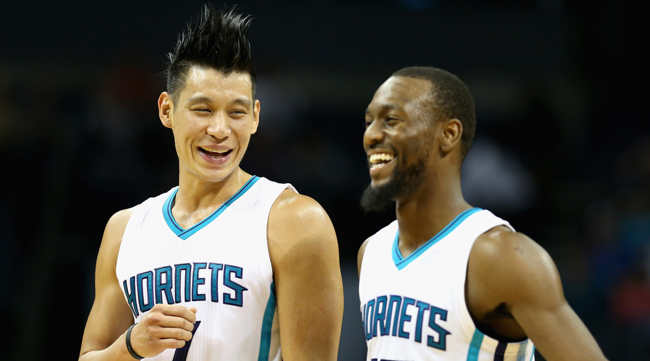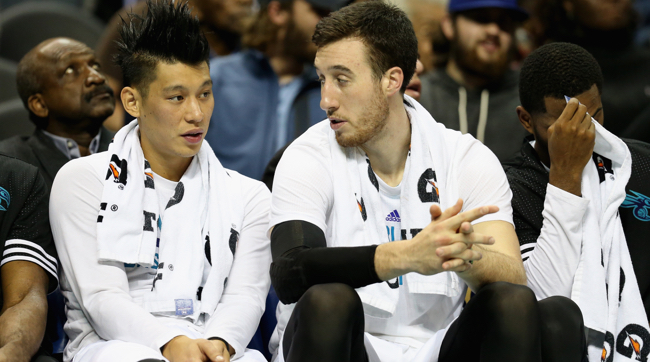
The 2015-16 NBA season starts soon, preseason hoops are in full swing, and playoff prognostications have begun in earnest. Because season previews can get bogged down by team-specific minutiae, and we cover every basketball team, we’re providing our readers reasons why you should care about all 30 teams in the Association.
DIME MAG’s 2015-16 NBA Season Previews
Just when the Hornets looked like a fun addition to the Eastern Conference, last year happens. In 2013-14, Al Jefferson gave them a low-post threat, Kemba Walker resembled something akin to a threat on the perimeter, Steve Clifford instituted a basic game plan on the defensive end, and the Hornets rode that to a surprising playoff appearance. But that trend didn’t continue last season, and now we’re here: One Frank Kaminsky draft pick and a Michael Kidd-Gilchrist injury later.
After last year happened, all the franchise’s momentum ground to a halt, like an Al Jefferson isolation. Their defense was still top 10, but they couldn’t score any points. The Lance Stephenson signing turned into a debacle and they eventually needed to rely on Mo Williams — Mo Williams! — to actually score some points.
Will drafting a four-year senior with a fun millennial vibe and shot-making ability all over the floor improve things? Or will it be more of the same? We’re leaning towards the latter, because while Frank is a ton of fun, all those Boston picks in exchange for that No. 9 spot would have been a smarter decision for the long-term prospects of this franchise. Regardless of why it happened, we’re here now, with the season about to start.
Nic Batum might be a nice band-aid in the meantime, but he’s free agent this summer, as is Big Al. Kemba Walker has a newer deal, but he’s a high volume shooter in a game that’s finally figured out how to streamline its efficiency. A ton of long two-pointers — a Kemba specialty — isn’t going to cut it, no matter how many game winners he hits. Frank is a nice offensive player, but he should never be a team’s No. 2 scorer, or even their primary third option. Jeremy Lin was also a nice pickup, but he’ll always just be a talented backup hybrid guard who can score and dish in bunches, but is a minus on defense and can’t be expected to drastically improve a team on a nightly basis. That said, he looked terrific in the preseason.
The Hornets will be in the middle of the pack in the lesser of the two conferences, but let’s stop talking about why they’re inconsequential and focus on what makes them more interesting than their on-court product’s popularity might infer.
Frank Kaminsky and the now-absent Michael Kidd-Gilchrist
The Charlotte Hornets had two tantalizing options with No. 9 pick of June’s draft: Accept a wild trade package from the Boston Celtics that contained as many as four first-round picks, or end Justise Winslow’s slide by simply selecting the player a vocal consensus deemed was the best on the board. But Michael Jordan opted to stick to his status quo instead, taking college senior Frank Kaminsky.
To say Charlotte made a mistake by selecting Kaminsky is an indictment of the team as opposed to the player. The former big man is an effortless shooter from all over the floor, and has enough oomph off the bounce to effectively supplement his advanced footwork, too. He’ll almost surely make a positive impact offensively before his career is over. But Kaminsky has a ceiling, too, and it’s one certainly lower than not just Winslow’s, but the collective worth of four first-rounders.
Bringing in a rookie to help immediately makes sense for some teams. They rarely choose in the lottery, though, and always possess realistic aspirations of title contention. That’s not the Hornets, obviously, and it hasn’t been for quite some time. But that hasn’t stopped Jordan and company from making every move with a clear intention of winning now, a backwards approach that reared its ugly head when Michael Kidd-Gilchrist was lost for the season with a torn labrum earlier this month.

Let Charlotte serve as a lesson for why franchises with nothing but low-rung playoff hopes should play more for the future than the present. Things happen in the NBA. Players get injured. Others underperform. Some don’t play as together as they do in theory on paper. And there’s no way to predict when, why, and if those entirely mitigating circumstances can occur.
Without the sweeping defensive influence of Kidd-Gilchrist, the Hornets seem most likely to be on the postseason sidelines come spring. And if that proves the case, how likely is Al Jefferson to re-sign next summer? What about Nicolas Batum? Which begs an even bigger question: If either their incumbent free agent walks or the team strikes out on the open market with big-name players, will Charlotte finally commit to a re-build?
Don’t count on it, but also not anything else, either – which is exactly how this franchise should have approached the draft. If the Hornets had, the injury to Kidd-Gilchrist wouldn’t even have the chance to be forever crippling, but just a minor hitch on their walk to long-term success.
Big Al

Al Jefferson gets it. Perhaps no player seems like a man out of time more than Charlotte’s flat-footed center. But Jefferson is so elite at what he does — score around the basket — he’s still a commodity in an NBA that’s increasingly becoming a three-point shooting exhibition.
We’ll see just how much import he carries when his contract ends at the conclusion of this season, but for now he’s one of the biggest — both literally and figuratively — reasons to tune into MJ’s middling bunch. As mentioned above, that’s a problem in today’s NBA. You either want to be elite in the East, or so dreadful you get some young, cheap, rookie talent.
Frank Kaminsky isn’t young, though he is cheap because he’s a rookie. Al Jefferson is none of those things. Regardless of how Nic Batum, Jeremy Lin, ball-dominant Kemba Walker and Frank the Tank mix and match their medley of offensive skills, the man they call Big Al will be a rumbling beast of the block, pump-faking and pivoting his way to 18 and nine. He’s got all of Shawn Marion’s little bunny shots from six feet, and a back-to-the-basket game that rivals Tim Duncan in its technical proficiency, footwork, misdirection and effectiveness.
No, Big Al isn’t Tim Duncan. Not even close. But he’s worked hard on turning into a passable pick-and-roll defender, and he’s stayed somewhat healthy and effective enough to demand a double-team if the defender on the block isn’t up to the challenge. That might be the only way Charlotte can drum up points some nights.
Plus, he’s cut chicken from his diet and dropped 25 pounds at the behest of Duncan. No one saved their knees more trouble than Duncan did the last half decade, and Jefferson is wise to follow suit.
In the preseason, the Hornets were top-10 in points allowed and points scored per possession. That’s terrific news, but more so if it hadn’t come in the preseason. It likely won’t translate once the real play begins.
Despite all this, Al Jefferson will be down on the block, grinding away and making the young guns look foolish with his shot fakes. There’s something almost regal about that sort of night in and night out lunch-pail mentality. Jefferson’s about to put on his hard hat and go to work for the next half year. His game might be the furthest thing from art, but it’s effective and noble in its own way. Sorta like this Hornets team.






